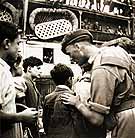
|
|
|

|

|

|

|
|
Click on an image to see a larger, more detailed picture.
|
|
|
|
|
| EPILOGUE: The Aftermath |

|
pg. 656 |

|
|
|
|
| |
 The illegal immigrant ship Theodor Herzl arrived in Haifa, Palestine, in 1947. The banner reads: "The Germans destroyed our families....Don't you destroy our hopes."
The illegal immigrant ship Theodor Herzl arrived in Haifa, Palestine, in 1947. The banner reads: "The Germans destroyed our families....Don't you destroy our hopes."
Photo: Central Zionist Archives, Jerusalem/ Beth Hatefutsoth, Tel Aviv
|
 A British soldier forces Jewish children to disembark from the Exodus 1947 in July 1947.
A British soldier forces Jewish children to disembark from the Exodus 1947 in July 1947.
Photo: Ruth Gruber
|
|
The notion of a Jewish state was described in 1896 by Zionist leader Theodor Herzl as a "kingly dream." That dream did become a reality, but not before nightmares occured that Herzl neither lived to experience nor ever imagined. A biblical term, aliyah, meaning "ascent," designates an uphill journey to Jerusalem; it is used generally to refer to immigration to Israel. Between 1882 and 1903, about 30,000 Jews immigrated to Palestine, which more than doubled the region's Jewish population. That number was small, however, in contrast to the 500,000 Jews from Eastern Europe and Russia who entered the United States during the same period. Another 35,000 Jews went to Palestine in the Second Aliyah (1904-1914), again representing a small fraction of the 1.5 million Jews who fled Eastern Europe's relentless pogroms during those ten years. By 1914, Palestine was home to half a million Arabs and 85,000 Jews. Deep British economic and strategic interests in the Middle East, particularly control of the Suez Canal, led to Britain's Balfour Declaration, named after Foreign Secretary Arthur James Balfour. It made clear that the British government favored "the establishment in Palestine of a national home for the Jewish people, and will use their best endeavors to facilitate the achievement of this object, it being clearly understood that nothing shall be done which may prejudice the civil and religious rights of existing non-Jewish communities in Palestine, or the rights and political status enjoyed by Jews in any other country." The Balfour Declaration appeared shortly after British troops invaded Palestine in October 1917. By the next September, the entire region was under British control. Under postwar terms established by the newly formed League of Nations, Palestine became a British mandate. The British were then left to oversee a Palestine whose majority Arab population was not pleased to find that Palestine's minority Jewish population was increasingly committed to work for the Balfour Declaration's promised statehood.
|
|

|

|

|

|
 1947: Jozef Tiso, former prime minister of Slovakia and an ally to Adolf Hitler, is tried and executed in Czechoslovakia.
1947: Jozef Tiso, former prime minister of Slovakia and an ally to Adolf Hitler, is tried and executed in Czechoslovakia.
|
 1947: Swedish diplomat Raoul Wallenberg dies in a Soviet prison (according to a 1956 Soviet report).
1947: Swedish diplomat Raoul Wallenberg dies in a Soviet prison (according to a 1956 Soviet report).
|
 1947: Belgian government minister Jean Terfve, a Communist, pushes through a law to commemorate Jewish victims of Nazi persecution.
1947: Belgian government minister Jean Terfve, a Communist, pushes through a law to commemorate Jewish victims of Nazi persecution.
|
 January 4-December 4, 1947: The trial of 15 Nazi judges takes place at Nuremberg, Germany. Four are sentenced to life in prison, four to ten years, one to seven years, and one to five years. Four are acquitted and one is released because of ill health.
January 4-December 4, 1947: The trial of 15 Nazi judges takes place at Nuremberg, Germany. Four are sentenced to life in prison, four to ten years, one to seven years, and one to five years. Four are acquitted and one is released because of ill health.
|
 January 13-November 3, 1947: Eighteen former members of Nazi Germany's Wirtschafts- und Verwaltungshauptamt (Economy and Administration Main Office) are tried at Nuremberg. Four are sentenced to death and 11 to imprisonment; three are acquitted.
January 13-November 3, 1947: Eighteen former members of Nazi Germany's Wirtschafts- und Verwaltungshauptamt (Economy and Administration Main Office) are tried at Nuremberg. Four are sentenced to death and 11 to imprisonment; three are acquitted.
|
 February 8-December 22, 1947: Six German industrialists, including Friedrich Flick, are tried at Nuremberg. Three are sentenced to prison; three are acquitted.
February 8-December 22, 1947: Six German industrialists, including Friedrich Flick, are tried at Nuremberg. Three are sentenced to prison; three are acquitted.
|
|
|
|
|
| EPILOGUE: The Aftermath |

|
pg. 656 |

|
|
The Holocaust Chronicle
© 2009 Publications International, Ltd.
|
|
